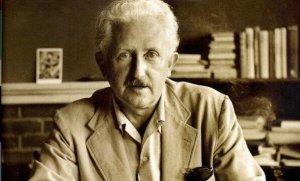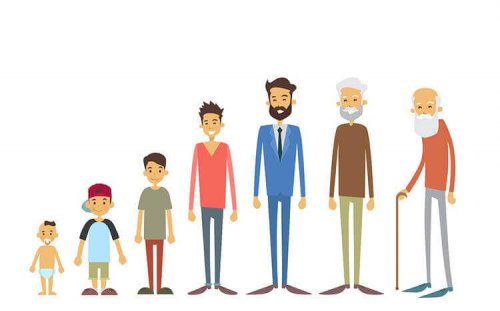Erik Erikson, A Different Kind of Psychoanalyst

Erik Erikson was a German psychoanalyst who made important contributions to our understanding of the human mind. He was born in Frankfurt in 1902 and died nearly a century later in Massachusetts in 1994.
Erik Erikson’s main contribution was in the field of evolutionary psychology. He proposed the existence of eight stages of development. In spite of the fact that he studied and worked as a psychoanalyst, his theories are widely used in humanist psychology.
“In the social jungle of human existence, there is no feeling of being alive without a sense of identity.”
-Erik Erikson-
As is often the case with important psychologists and psychoanalysts, Erik Erikson’s childhood wasn’t perfect. His father left his mother right when Erikson was born. Erikson’s mother was a young Danish woman who raised her son as a single mom during the first years of his life. A few years later, she married a pediatrician of Jewish origin.
Erik Erikson’s youth
Erik Erikson’s mother hid the fact that his father had abandoned them. Perhaps that’s why he grew up as kind of a rebel without a cause. He didn’t have a lot of direction or specific goals. In spite of the fact that he was a good student, he didn’t excel and everyone believed him to be distracted and unsettled.

When he finished high school, he decided he wanted to be an artist. That was the beginning of a very unstable time in his life. He went to classes and traveled to different parts of Europe to learn about artistic movements in the continent. He sometimes traveled as a bum and slept under bridges.
Much later, Erik Erikson wrote an essay titled Autobiographic Notes on the Identity Crisis. In this essay, he wrote about those years when he was wandering and wasn’t sure what path to take.
Early education
When Erikson turned 25, he decided he wanted to settle down. A friend of his recommended he take an open position at an experimental school. The school’s director was Dorothy Burlingham, a close friend of Anna Freud. It was at this school that Erikson began to find himself and figure out his life’s work.
He became interested in pedagogy and became certified in Montessori education. Later, thanks to Anna Freud‘s influence, he studied child psychoanalysis at the Vienna Psychoanalytic Society. He then decided to become a psychoanalyst. Anna Freud herself psychoanalyzed him as part of his requirements to start his practice.

Erik Erikson married a ballerina, and some years later they had to face the hardships of World War II. This forced them to immigrate to the United States, where Erikson quickly found a job as a teacher at Harvard University. He made some friends there who significantly impacted his life. He would also later work at Yale University and the University of California.
Erik Erikson’s evolutionary theory
Although Erikson worked on a wide variety of subjects, his theory of psychosocial development was what gave him a prominent place in the world of psychology. In this theory, he brought together his knowledge of pedagogy, psychoanalysis, and cultural anthropology. Erikson basically reinterpreted Sigmund Freud’s psychosexual phases of development.

Erikson created the psychology of the ego, which he considered the essential force of human life. He believed that the social aspect of human beings and the biological development were determining elements of an individual’s life. He proposed that we acquire certain specific skills in each stage of our lives. Those skills determine subsequent evolution. The skills he described are basically psychosocial and imply a conflict between the previous state and the new one.
The eight stages of development, according to Erik Erikson, are the following (in this order):
- Trust vs. Mistrust
- Autonomy vs. Shame and Doubt
- Initiative vs. Guilt. …
- Industry vs. Inferiority
- Identity vs. Role Confusion
- Intimacy vs. Isolation
- Generativity vs. Stagnation
- Ego Integrity vs. Despair
Erik Erikson’s theory had an important impact on North American psychology. Later on, that impact spread to the rest of the world. Today, his theory still has a significant influence on research and the therapeutic field. It’s an interesting, profoundly human, and hopeful focus.
Erik Erikson was a German psychoanalyst who made important contributions to our understanding of the human mind. He was born in Frankfurt in 1902 and died nearly a century later in Massachusetts in 1994.
Erik Erikson’s main contribution was in the field of evolutionary psychology. He proposed the existence of eight stages of development. In spite of the fact that he studied and worked as a psychoanalyst, his theories are widely used in humanist psychology.
“In the social jungle of human existence, there is no feeling of being alive without a sense of identity.”
-Erik Erikson-
As is often the case with important psychologists and psychoanalysts, Erik Erikson’s childhood wasn’t perfect. His father left his mother right when Erikson was born. Erikson’s mother was a young Danish woman who raised her son as a single mom during the first years of his life. A few years later, she married a pediatrician of Jewish origin.
Erik Erikson’s youth
Erik Erikson’s mother hid the fact that his father had abandoned them. Perhaps that’s why he grew up as kind of a rebel without a cause. He didn’t have a lot of direction or specific goals. In spite of the fact that he was a good student, he didn’t excel and everyone believed him to be distracted and unsettled.

When he finished high school, he decided he wanted to be an artist. That was the beginning of a very unstable time in his life. He went to classes and traveled to different parts of Europe to learn about artistic movements in the continent. He sometimes traveled as a bum and slept under bridges.
Much later, Erik Erikson wrote an essay titled Autobiographic Notes on the Identity Crisis. In this essay, he wrote about those years when he was wandering and wasn’t sure what path to take.
Early education
When Erikson turned 25, he decided he wanted to settle down. A friend of his recommended he take an open position at an experimental school. The school’s director was Dorothy Burlingham, a close friend of Anna Freud. It was at this school that Erikson began to find himself and figure out his life’s work.
He became interested in pedagogy and became certified in Montessori education. Later, thanks to Anna Freud‘s influence, he studied child psychoanalysis at the Vienna Psychoanalytic Society. He then decided to become a psychoanalyst. Anna Freud herself psychoanalyzed him as part of his requirements to start his practice.

Erik Erikson married a ballerina, and some years later they had to face the hardships of World War II. This forced them to immigrate to the United States, where Erikson quickly found a job as a teacher at Harvard University. He made some friends there who significantly impacted his life. He would also later work at Yale University and the University of California.
Erik Erikson’s evolutionary theory
Although Erikson worked on a wide variety of subjects, his theory of psychosocial development was what gave him a prominent place in the world of psychology. In this theory, he brought together his knowledge of pedagogy, psychoanalysis, and cultural anthropology. Erikson basically reinterpreted Sigmund Freud’s psychosexual phases of development.

Erikson created the psychology of the ego, which he considered the essential force of human life. He believed that the social aspect of human beings and the biological development were determining elements of an individual’s life. He proposed that we acquire certain specific skills in each stage of our lives. Those skills determine subsequent evolution. The skills he described are basically psychosocial and imply a conflict between the previous state and the new one.
The eight stages of development, according to Erik Erikson, are the following (in this order):
- Trust vs. Mistrust
- Autonomy vs. Shame and Doubt
- Initiative vs. Guilt. …
- Industry vs. Inferiority
- Identity vs. Role Confusion
- Intimacy vs. Isolation
- Generativity vs. Stagnation
- Ego Integrity vs. Despair
Erik Erikson’s theory had an important impact on North American psychology. Later on, that impact spread to the rest of the world. Today, his theory still has a significant influence on research and the therapeutic field. It’s an interesting, profoundly human, and hopeful focus.
This text is provided for informational purposes only and does not replace consultation with a professional. If in doubt, consult your specialist.







